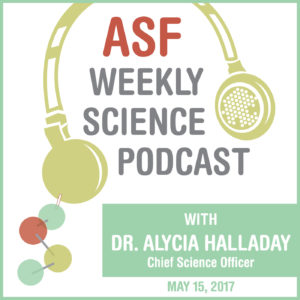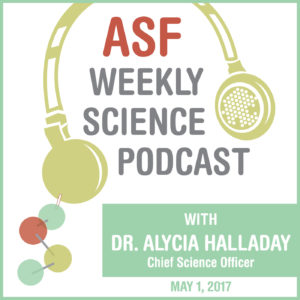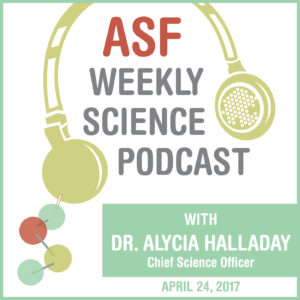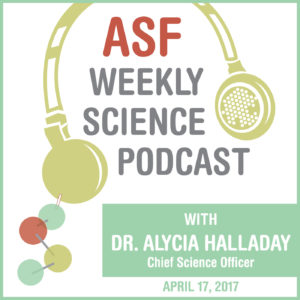John Oliver took aim at vaccine skeptics on Sunday’s Last Week Tonight, blaming the misinformation and confusion on everything from the rising popularity of memes to Donald Trump’s statements on the campaign trail. You can see the whole video, which featured Alison Singer, President and Co-Founder of ASF, here.
 In order to ensure that researchers have enough brain tissue to understand autism spectrum disorders, the education and outreach campaign of the Autism BrainNet is being expanded past families to doctors and professionals that have access to tissue. One of these groups is neuropathologists. At their annual meeting this past week in Los Angeles, an entire afternoon was spent dedicated to autism and the features of autism in the brain. A summary of the presentations is included in this podcast. Speakers emphasized that the way the brain works in childhood is not the same as the way it works in adulthood, and a study out of UCSD showed that the genes that are affected in children with autism are different than those in adults with autism. The mechanisms of genes controlling the developing brain vs. those which affect ongoing maintenance are different. This calls to make sure scientists understand all ages of people with autism, because as the brain changes, so do the needs of people with ASD.
In order to ensure that researchers have enough brain tissue to understand autism spectrum disorders, the education and outreach campaign of the Autism BrainNet is being expanded past families to doctors and professionals that have access to tissue. One of these groups is neuropathologists. At their annual meeting this past week in Los Angeles, an entire afternoon was spent dedicated to autism and the features of autism in the brain. A summary of the presentations is included in this podcast. Speakers emphasized that the way the brain works in childhood is not the same as the way it works in adulthood, and a study out of UCSD showed that the genes that are affected in children with autism are different than those in adults with autism. The mechanisms of genes controlling the developing brain vs. those which affect ongoing maintenance are different. This calls to make sure scientists understand all ages of people with autism, because as the brain changes, so do the needs of people with ASD.
Click here to listen to this week’s podcast with ASF Chief Science Officer Dr. Alycia Halladay Ross.
 In this week’s podcast with Dr. Alycia Halladay Ross, she discusses two new publications that reported on systematic reviews for nutritional and sensory treatments for ASD. This means the existing research was sorted, summarized, scrutinized and evaluated. The reviews found insufficient evidence to show that any dietary or nutritional therapy was effective, but sufficient evidence that sensory integration therapy helps people with ASD. In light of new data on heavy metals found in baby teeth, it is important to remember that chelation is NOT effective and dangerous. While “insufficient evidence” does not rule out these interventions forever and always, lots more needs to be done in these areas to conduct rigorous experiments that don’t have any major shortcomings so they hold up to scrutiny.
In this week’s podcast with Dr. Alycia Halladay Ross, she discusses two new publications that reported on systematic reviews for nutritional and sensory treatments for ASD. This means the existing research was sorted, summarized, scrutinized and evaluated. The reviews found insufficient evidence to show that any dietary or nutritional therapy was effective, but sufficient evidence that sensory integration therapy helps people with ASD. In light of new data on heavy metals found in baby teeth, it is important to remember that chelation is NOT effective and dangerous. While “insufficient evidence” does not rule out these interventions forever and always, lots more needs to be done in these areas to conduct rigorous experiments that don’t have any major shortcomings so they hold up to scrutiny.
Dr. Donna Werling from UCSF, Autism Science Foundation fellow, was featured in “Scientific American” for her recent study on the differences between male and female brain development. Click here to learn more.
 Lots of people tend to think of the genetics of disorders/disease as being one mutation/genetic variation inherited from the mother/father that causes a trait directly. Unfortunately, the genetics of autism isn’t that simple or scientists would have found “the gene” by now. In fact, there are different types of genetic influences in autism. A new study in Nature Genetics led by Elise Robinson shows how common variation influences autism risk, as well as intellectual function in autism, compared to de novo mutations. There is a short primer at the beginning of the podcast about old-school genetic thinking and why it doesn’t apply to ASD.
Lots of people tend to think of the genetics of disorders/disease as being one mutation/genetic variation inherited from the mother/father that causes a trait directly. Unfortunately, the genetics of autism isn’t that simple or scientists would have found “the gene” by now. In fact, there are different types of genetic influences in autism. A new study in Nature Genetics led by Elise Robinson shows how common variation influences autism risk, as well as intellectual function in autism, compared to de novo mutations. There is a short primer at the beginning of the podcast about old-school genetic thinking and why it doesn’t apply to ASD. This week’s International Meeting for Autism Research was filled with important presentations on the multiple causes of autism, interventions, diagnosis, neurobiology, services, family and self-advocate perspectives; the list goes on and on. There is a great recap on Spectrum (click here). An underlying theme ran through the presentations: that is, that the previous “well, we don’t see differences because there is lots of heterogeneity in autism” explanation isn’t cutting it anymore. We know people with autism are different, and parents, self-advocates and researchers are starting to deal with it by stratifying groups by their genetic backgrounds. While not a complete solution to this challenge, research at IMFAR shows that identifying different subgroups based on genetics is helping to explain symptoms.
This week’s International Meeting for Autism Research was filled with important presentations on the multiple causes of autism, interventions, diagnosis, neurobiology, services, family and self-advocate perspectives; the list goes on and on. There is a great recap on Spectrum (click here). An underlying theme ran through the presentations: that is, that the previous “well, we don’t see differences because there is lots of heterogeneity in autism” explanation isn’t cutting it anymore. We know people with autism are different, and parents, self-advocates and researchers are starting to deal with it by stratifying groups by their genetic backgrounds. While not a complete solution to this challenge, research at IMFAR shows that identifying different subgroups based on genetics is helping to explain symptoms.
Click here to listen to this week’s podcast with ASF Chief Science Officer Dr. Alycia Halladay.
Autism Science Foundation grantees and fellows will be giving several presentations throughout the International Meeting for Autism Research (IMFAR) in San Francisco this week. If you will be at IMFAR, see details below so you can attend their presentations. If not, see below anyway to learn about the great work ASF grantees and fellows are doing. We will be posting on Facebook and tweeting all throughout the conference!
Thursday, May 11th
Karen Chenausky
Session Title: Communication and Language
Session Date/Time: Thursday, May 11, 2017, 12:00 PM – 1:40 PM
Poster Title: Predictors of Speech Improvement in Minimally Verbal Children with Autism Spectrum Disorder
Christine Ochoa
Session Title: Animal Models
Session Date/Time: Thursday, May 11, 2017, 12:00 PM – 1:40 PM
Poster Title: Loss of KCTD13 Decreases Hippocampal Synaptic Transmission Via the Small Gtpase RhoA
Dara Chan
Session Title: Adult Outcome: Medical, Cognitive, Behavioral
Session Date/Time: Thursday, May 11, 2017, 5:30 PM – 7:00 PM
Poster Title: Examining Environmental Predictors of Social Participation and Service Use for Adults with ASD Using Geographic Information Systems (GIS)
Friday, May 12th
Jacqueline Barkoski
Session Title: Epidemiology
Session Date/Time: Friday, May 12, 2017, 12:00 PM – 1:40 PM
Poster Title: In Utero Pyrethroid Pesticide Exposure and Child Cognitive Development from 6 to 36 Months in the Marbles Longitudinal Cohort
Saturday, May 13th
Tychele Turner
Session Title: Gene Discovery in ASD
Session Date/Time: Saturday, May 13, 2017, 1:15 PM-2:05 PM
Presentation Title: Genome Sequencing of 2,064 Genomes from 516 Simplex Families with Autism
Oral Presentation Start Time: 1:15 PM
Donna Werling (on behalf of Stephan Sanders)
Session Title: Gene Discovery in ASD
Session Date/Time: Saturday, May 13, 2017, 1:15 PM-2:05 PM
Presentation Title: Interaction Between Human Sexual Dimorphism and ASD Neurobiology
Oral Presentation Start Time: 1:39 PM
Shweta Ghai
Session Title: Early Development (< 48 months)
Session Date/Time: Saturday, May 13, 2017, 12:00 PM – 1:40 PM
Poster Title: Physiological Measurements of Voice Quality in Children with Autism Using Electroglottography in Relation to Clinical Assessment Outcome
Aarti Nair
Session Title: Early Brain Development
Session Date/Time: Saturday, May 13, 2017, 2:10 PM-3:00 PM
Presentation Title: Altered Early Development of Resting-State Network Properties in Infants at High Risk for Autism Spectrum Disorder
Oral Presentation Start Time: 2:10 PM
To view the statement in its original form, click here.
The release of new practice guidelines co-developed by the American Academy of Neurology (AAN) and the American Epilepsy Society (AES) on the issue of Sudden Unexpected Death in Epilepsy (SUDEP) is a benchmark moment for everyone impacted by epilepsy. Historically, the communication between medical professionals and their patients about SUDEP risk has been unacceptably low. Too often, family members have learned about SUDEP only after they have lost a loved one. A change in practice is long overdue.
For the first time, the AAN and AES are issuing a definitive and public recommendation for neurologists to inform all populations suffering from epilepsy about the risk of SUDEP, the most common cause of mortality for people with epilepsy. Every patient and parent deserves and needs to be educated about the range of risks that accompany epilepsy, including one as serious as SUDEP.
The guidelines send the critical message that anyone who suffers generalized tonic-clonic seizures is at risk for SUDEP. The frequency of these seizures elevates the risk, and people who have three or more convulsive seizures per year face a 15-fold increased threat. Minimizing seizures through specialized medical care and strategies to reduce breakthrough seizures are the best methods to reduce risk. Since SUDEP happens more often in sleep, nighttime supervision or monitoring may also help and should be part of the patient/provider conversation. While the report assigns a blanket SUDEP risk ratio to children, it is important to note that certain pediatric populations – children with Dravet syndrome, Dup15q syndrome, and others – face a significantly higher risk ratio.
We hope these recommendations lead to increased disclosure rates and better standards of care. Yet much more remains to be done to advance our understanding of SUDEP and its prevention. This report underscores a systemic and ongoing failure to conduct necessary surveillance and prevention trials, and to adequately educate medical examiners, doctors and patients about SUDEP. Major progress is crucial, and will require increased collaboration among medical professionals, public health experts, families, researchers and advocates.
We urge all medical professionals to use these recommendations to initiate an honest and ongoing conversation that is tailored to their patient’s risk level. Furthermore, we urgently call for expanded research to better our understanding of SUDEP incidence, risk factors and to identify additional prevention strategies that could save lives.
About Epilepsy and SUDEP
Epilepsy is a neurological condition that is typically diagnosed after two or more unprovoked seizures. The disease affects nearly 3 million Americans – more people than multiple sclerosis, cerebral palsy, muscular dystrophy and Parkinson’s combined – yet receives fewer federal dollars per patient than each. A death is referred to as SUDEP when a seemingly healthy person with epilepsy dies unexpectedly and no clear reason for the death can be determined. SUDEP takes more lives annually than house fires and SIDS combined.
Signed,
Danny Did Foundation
CURE, Citizens United for Research in Epilepsy
Epilepsy Foundation
NASR: North American SUDEP Registry
Autism Speaks
FACES: Finding a Cure for Epilepsy and Seizures
Tuberous Sclerosis Alliance
Dup15q Alliance
Dravet Syndrome Foundation
Autism Science Foundation
SUDEP Action
 Scientists have studied males compared to females with autism, but rarely have there been studies about what clinicians see as differences in these two groups. Given that they provide insight on diagnosis, needs and access to services, it is kind of important to talk to them, and a study out this week in the journal Autism did just that. Click here to read the study.
Scientists have studied males compared to females with autism, but rarely have there been studies about what clinicians see as differences in these two groups. Given that they provide insight on diagnosis, needs and access to services, it is kind of important to talk to them, and a study out this week in the journal Autism did just that. Click here to read the study.
Also, scientists are starting to understand the role of exposures in parents and how they affect diagnosis of autism in their children, but this week a new wrench was thrown into the wheel: researchers in the UK found that grandparental exposures play a role in autism diagnosis too. Luckily, this too is open access and you can read it for yourself here. It was covered in the media and we have perspective from a parent included.
Click here to listen to this week’s podcast with Dr. Alycia Halladay.
ASF Chief Science Officer Dr. Alycia Halladay commented on a new study on the risk of autism if an individual’s grandmother smoked during pregnancy. While the study cannot prove cause-and-effect, the researchers have discovered a link here. Click here to read more.
 This week’s podcast with Dr. Alycia Halladay summarizes some new studies looking at autism traits and autism diagnosis in girls with anorexia nervosa. While the two disorders may seem different at the outset, they do share some behavioral features. Unfortunately, most studies look at autism in those with anorexia, not the other way around. However, what is known is that there is not only higher levels of ASD traits in girls with anorexia, but about 10% of girls with anorexia also have an autism diagnosis. This number can only be trusted if you look at both standardized observation instruments AND parental report. Studies determining the rates of eating disorders in autism are desperately needed for better treatment of symptoms. Learn more by listening to the podcast here.
This week’s podcast with Dr. Alycia Halladay summarizes some new studies looking at autism traits and autism diagnosis in girls with anorexia nervosa. While the two disorders may seem different at the outset, they do share some behavioral features. Unfortunately, most studies look at autism in those with anorexia, not the other way around. However, what is known is that there is not only higher levels of ASD traits in girls with anorexia, but about 10% of girls with anorexia also have an autism diagnosis. This number can only be trusted if you look at both standardized observation instruments AND parental report. Studies determining the rates of eating disorders in autism are desperately needed for better treatment of symptoms. Learn more by listening to the podcast here.
 As always, good news and bad news in autism this week. First the good news: an intervention given between 9-14 months of age in children with a high probability of having an autism diagnosis improved autism symptoms at 3 years of age. Now the bad: mothers who experience severe childhood abuse are more likely to have a child with an autism diagnosis. Why? A new study explains it might have a lot to do with autism traits in the parents.
As always, good news and bad news in autism this week. First the good news: an intervention given between 9-14 months of age in children with a high probability of having an autism diagnosis improved autism symptoms at 3 years of age. Now the bad: mothers who experience severe childhood abuse are more likely to have a child with an autism diagnosis. Why? A new study explains it might have a lot to do with autism traits in the parents.
Click here to listen to this week’s podcast with Dr. Alycia Halladay.

